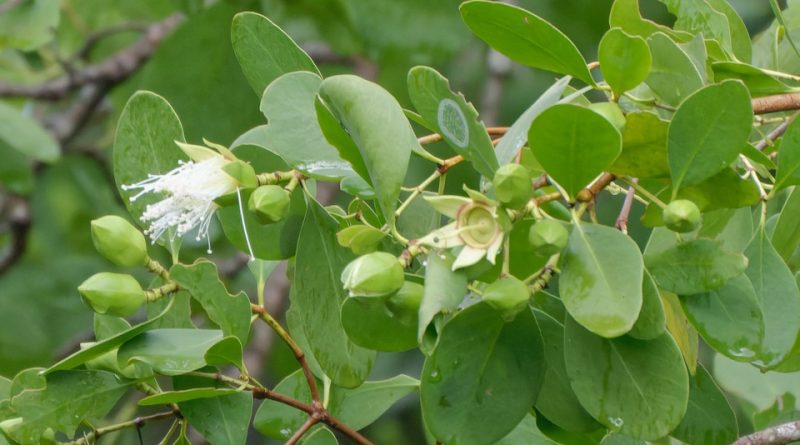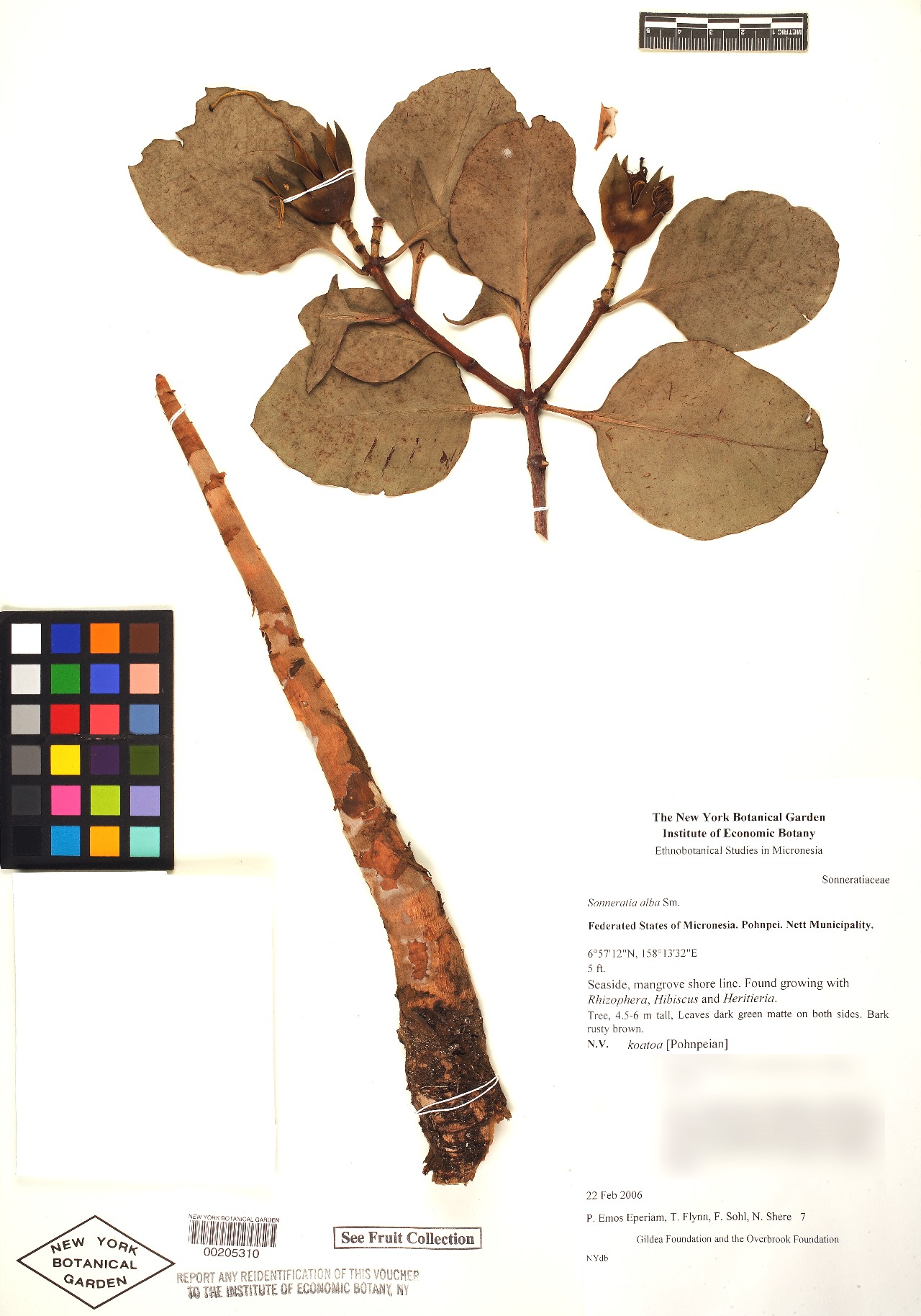Sonneratia alba
Sonneratia alba
The mangrove apple (Sonneratia alba Sm., 1816) is an arboreal species belonging to the Sonneratiaceae family.
Systematic –
From a systematic point of view it belongs to:
Eukaryota domain,
Kingdom Plantae,
Subkingdom Tracheobionta,
Spermatophyta Superdivision,
Division Magnoliophyta,
Class Magnoliopsida,
Subclass Rosidae,
Order Myrtales,
Family Sonneratiaceae,
Genre Sonneratia,
S. alba species.
The terms are synonymous:
– Blatti alba (Sm.) Kuntze;
– Blatti leucantha (Montrouz.) Kuntze;
– Blatti pagatpat (Blanco) Nied.;
– Chiratia leucantha Montrouz.;
– Sonneratia acida Benth.;
– Sonneratia acida var. mossambicensis (Klotzsch) Mattei;
– Sonneratia alba var. iriomotensis (Masam.) Masam.;
– Sonneratia griffithii Watson;
– Sonneratia iriomotensis Masam.;
– Sonneratia mossambicensis Klotzsch;
– Sonneratia mossambicensis Klotzsch ex Peters;
– Sonneratia pagatpat Blanco.
Etymology –
The term Sonneratia is in honor of the French naturalist and explorer Pierre Sonnerat (1748-1814).
The specific epithet alba comes from Latin and means white, in reference to the color of the petals and stamens.
Geographic Distribution and Habitat –
Sonneratia alba is a plant native to Africa: (Kenya, Madagascar, Mozambique, Seychelles, Somalia and Tanzania), Asia (China in Guangdong, Philippines, Japan in the Ryukyu Islands, India, Indonesia, Andaman and Nicobar Islands, Malaysia, Myanmar , Papua New Guinea, Thailand and Vietnam), Australia and the Pacific Islands (Solomon Islands, Micronesia, New Caledonia and Vanuatu), where it grows in its natural state in many tropical and subtropical areas from eastern Africa to the Indian subcontinent, to southern China, to the Ryukyu Islands, Indochina, Malaysia, Papua, Australia and the Western Pacific region.
Its habitat is that of sheltered, sandy coasts and tidal inlets, and widespread in the mangrove forests of the Indian Ocean and the central-western Pacific.
Description –
Sonneratia alba is an evergreen tree that can grow from 3 to 15 meters in height, with occasional specimens up to 30 meters, and with a trunk with a diameter of up to 70 cm. The foliage is expanded and the bark is fissured to fissured, brownish in color, turning gray under the tide mark.
The leaves are borne by a short petiole; they are simple, opposite, rather thick, light green in colour, elliptical to ovate to obovate in shape, 5-12 cm long and 4-8 cm wide, with a rounded and mucronate apex (provided with a rigid tip, extension of the central rib ).
The flowers are bisexual and positioned in a terminal manner, 4-6 cm in diameter, with the smell of sour milk, solitary or in groups of three, rarely five, which open at dusk and last only one night. They are made up of 5-8 erect ovoid-triangular sepals, then curved into fruit, 1.5-2 cm long, green on the outside, red on the inside, 5-8 linear white petals, of the same length as the sepals, 1-2 cm wide mm, and white stamens 4-6 cm long.
The pollination of this species is carried out by nocturnal insects and bats, mainly Eonycteris spelaea and Macroglossus minimus.
The fruits are globose-depressed berries, green in color, surrounded by persistent sepals, 2-5 cm in diameter.
Inside there are numerous small, white, flat, sickle-shaped and floating seeds (up to 200), which favors their dispersion.
Cultivation –
Sonneratia alba is an evergreen tree that is sometimes harvested in the wild for local use as a source of fuel, edible fruit, tannins, and cork substitute. It plays an important role in mangrove communities, helping to bind the soil and repair and protect the land behind it from erosion.
This plant prefers salt water and grows both on sandy or rocky soils and on muddy soils, not infrequently on coral terraces. Where it grows it requires a tidal range of at least one metre. The tree is in fact surrounded by a multitude of pneumatophore roots which are roots that emerge from the water or mud provided with an aeriferous tissue (aerenchyma) which allows the flow of oxygen to the submerged organs, 25-35 cm long in medium in size, conical in shape with a base up to 6 cm in diameter and a blunt apex, but which in some cases can reach and exceed one meter in height.
For cultivation, consider that it is a plant of the humid coastal areas of the tropics. It is successful in both areas without a dry season and those with a dry season. However, it is rarely cultivated outside its natural environment as it is difficult to recreate the conditions necessary for its survival. It is also intolerant of fresh water, which over time causes its death. Only a few specimens are present in botanical gardens.
It prefers a sunny position and, from a pedological point of view, consolidated muddy and sandy soils. Although it prefers heavy soil, it tolerates most soil types. In fact, it grows in areas flooded by salt water during high tide where it prefers a pH between 6.7 and 7.3, but tolerates a pH between 6.5 and 7.5.
The plants tolerate strong, salt-laden winds and respond well to coppice.
Propagation occurs by seed even if it has a low vitality, less than three months.
Customs and Traditions –
Sonneratia alba is a plant known by some common names, such as: apple mangrove (English); mlilana, mpia, mpira (Swahili); apfel-mangrove (German).
This plant is the most widespread of the genus and is of considerable importance for the coastal ecosystem of the Indo-Pacific area, predominant in some areas, such as the north-eastern coasts of Australia, where it helps prevent erosion and offer shelter and food for a multitude of living species.
It is a pioneer species that prefers high salinity and which contributes, with its dense pneumatophores, to stabilizing the muddy soil and therefore allowing the growth of other species.
The plant also has considerable importance in the life of local populations, the wood, due to its resistance to rot and lithophagous insects, is used in the construction of boats, to make pilings for bridges and houses and for window frames, where, due to the presence of traces of salt in the wood, nails and screws of corrosion-resistant material are used.
Wood is also used as fuel, although of low quality. The pneumatophore roots are used as floats for fishing nets.
The leaves are edible. They are locally consumed raw or cooked or used as fodder for livestock. Parts of the plant are used in traditional medicine; laboratory studies have confirmed the presence of a polysaccharide with anti-diabetic properties in the leaf extract.
From an ecological point of view, it is underlined that this species, although common in much of its range, is threatened due to the loss of habitat in mangrove swamps in general, mainly due to human activities. As a result, the tree has been classified as “Least Concern” in the IUCN Red List of Threatened Species (2010).
Other uses include agroforestry uses.
In fact, it is a very important tree in the coastal wetland community, as it helps protect the soil from erosion and provides important habitat for wildlife.
It can act as a pioneer, colonizing newly formed sandy mud flats in sheltered situations.
It is less suitable for replanting in sites where sedimentation is high as the sediment will cover the pneumatophores and therefore kill the plants.
Pneumatophores (vertical roots emerging from the soil) are sometimes used to make wooden shoe soles and are made into floats.
The bark contains 9 – 12% tannin, but is not often used as other, richer tannin species are more readily available.
A brownish dye is obtained from the bark.
The heartwood ranges from brown to reddish-brown in color; it is sharply delimited by the lighter sapwood, yet the tree rarely, if ever, forms heartwood.
The wood is moderately heavy, hard and durable. It contains small quantities of salts, which make it resistant to woodworms. These salts present in the wood corrode the metal and therefore special nails and screws are needed. Heavy lumber is resistant to moths and pests and is used to build boats, canoes, pilings and posts for decks and houses, carpentry, oars, masts, floats, and window and door frames.
The tree is cut only with inferior mixed firewood; for although it produces much heat, it also produces much ash and salt.
The wood is also used to make charcoal.
Preparation Method –
Sonneratia alba is a plant used almost exclusively by the populations of the area where it grows.
In the food sector, its fruits are consumed raw or cooked. They have a slightly acidic taste and are also used to make vinegar. The ripe fruit is said to taste like cheese.
The leaves are also eaten raw or cooked.
In the medicinal field the plant is used in traditional medicine to treat cuts and bruises.
The fruit is used to treat intestinal parasites and coughs.
In Borneo, S. alba is used as firewood. In Sulawesi wood is used in the construction of houses and ships. In Malaysia and Indonesia, the sour fruits are used to flavor fish and are sometimes eaten raw.
Guido Bissanti
Sources
– Acta Plantarum – Flora of the Italian Regions.
– Wikipedia, the free encyclopedia.
– GBIF, the Global Biodiversity Information Facility.
– Useful Tropical Plants Database.
– Conti F., Abbate G., Alessandrini A., Blasi C. (ed.), 2005. An annotated checklist of the Italian vascular flora, Palombi Editore.
– Pignatti S., 1982. Flora d’Italia, Edagricole, Bologna.
– Treben M., 2000. Health from the Lord’s Pharmacy, Advice and experiences with medicinal herbs, Ennsthaler Editore.
Photo source:
– https://inaturalist-open-data.s3.amazonaws.com/photos/323823106/original.jpg
– https://sweetgum.nybg.org/images3/281/589/v-242-00205310.jpg
Attention: Pharmaceutical applications and food uses are indicated for informational purposes only, they do not represent in any way a medical prescription; we therefore decline any responsibility for their use for healing, aesthetic or food purposes.


